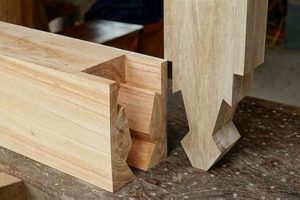
This particular method, often admired for both its structural integrity and visual appeal, involves inserting a shaped piece of wood across a joint to reinforce and stabilize it. The insert, typically wider... Read more »

Concealed connections in woodworking provide structural integrity while maintaining a seamless aesthetic. These joinery techniques prioritize hiding the mechanical elements, resulting in a finished piece where the method of assembly is not... Read more »
![Wood Joints: Types, Names & Joinery Guide [Woodwork] Step-by-Step Guides, Tools & Inspiration to Build Beautiful Wooden Decor on a Budget Wood Joints: Types, Names & Joinery Guide [Woodwork] | Step-by-Step Guides, Tools & Inspiration to Build Beautiful Wooden Decor on a Budget](https://woodfromhome.com/wp-content/uploads/2025/11/th-372-300x200.jpg)
Connections between pieces of wood are essential elements in woodworking. These connections, achieved through various methods, determine the strength, aesthetic, and function of the finished object. Specific terms denote the types of... Read more »

A fundamental element in the construction of robust and enduring wooden structures, this connection method involves fitting a projecting piece from one component into a mortise, or socket, in another. For example,... Read more »

These interlocking connections, often seen in box construction and edge-to-edge board joining, offer a significant mechanical advantage. The arrangement resembles interlaced fingers, hence the descriptive term. A common application is in drawer... Read more »

A woodworking technique, this joint connects two pieces of material lengthwise, creating a longer single piece. Characterized by angled or beveled mating surfaces, it maximizes the gluing area and distributing stress along... Read more »

A method of joining two pieces of wood edge-to-edge, this technique creates a seamless and visually appealing connection, often employed when greater width is required than a single board offers. It involves... Read more »

The pursuit of a structurally sound connection between pieces of wood is a fundamental concern in woodworking. Various methods exist, each offering a different balance of strength, ease of construction, and aesthetic... Read more »

The answer to a puzzle prompt referencing the connection of wooden elements often describes a specific type of joinery. This joinery involves techniques used to unite two or more pieces of timber,... Read more »

The terms refer to two distinct woodworking machines, each designed to perform different but complementary functions in preparing lumber. One is primarily used to create a flat, level surface on the faces... Read more »


